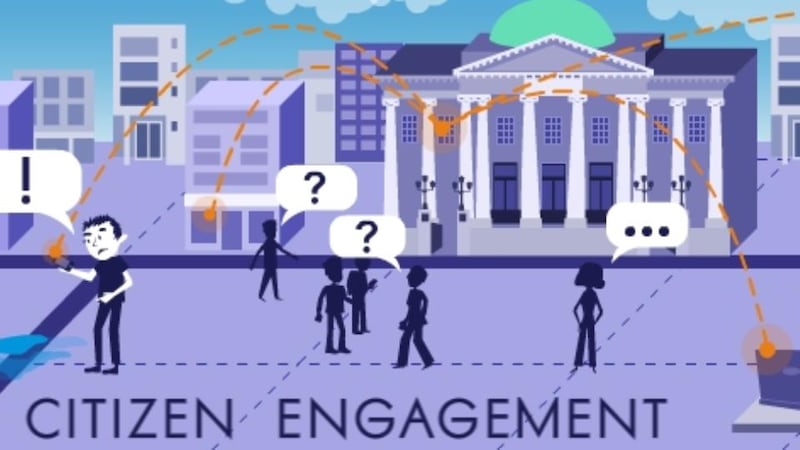Over the next two months thousands of sensors will be placed on local parking spaces and under the lids of public bins in the London borough of Milton Keynes.
As part of an 18-month pilot programme, Cambridge-based sensor developer Neul is partnering with BT and local authorities to ease traffic congestion, maximise parking revenue and save money on bin collections.
"They look very much like a cat's eye or a hockey puck," explains Neul's business development chief, Paul Egan. The "relatively low cost" sensors last for "around 10 years" from the power provided by two AA batteries.

“The [local] council is going to put [the sensors] down in public car parking spaces and run them through a mobile app which citizens can use to direct them to free spaces.”
Egan hopes that, in time, the technology could be used for purposes as varied as indicating when a rodent trap has fulfilled its purpose to tracking Alzheimer’s sufferers if they go missing.
Sensors and citizens
Peter Finnegan
, director of the office of economy and international relations at
Dublin City Council
tells
The Irish Times
the quest to make public savings through sensors and citizen engagement in Dublin has been ongoing.
“The internet of things is really another way of saying the devices you [use] start to talk to one another. That’s been going on a while now,” he says, adding that ‘smart city’ initiatives in one form or another have “been in Dublin for eight years”.
Sustainable cities
However, it was the late 2012 launch of the Sustainable Connected Cities project – a joint venture between the council,
Intel
Labs and researchers at
Trinity College
– which piqued the interest of many.
The umbrella project for “citizen-centric services and solutions” saw Intel deploy sensors in the city measuring air quality and other environmental factors, while 100 volunteers – 50 from Dublin City Council, 50 from Trinity College – took part in the pilot of a project called City Watch in which they were encouraged feed data back on issues such as transport and local services through a mobile app.
Prof Siobhán Clarke – director of Trinity’s Future Cities Research Centre, itself was launched in last July – says City Watch has produced “some results” thus far but “needs a wider user base” before publishing any findings.
“Our energies are now on getting the infrastructure in place before we can start going forward with more comprehensive, large sale deployments.”
Grand plans
With Neul’s Milton Keynes project pointing towards relatively swift savings from what seem like quite simple applications of their sensors, the grand aims of the Sustainable Connected Cities project (launched in order to help restructure “city services around environmental challenges”) have, Finnegan admits, meant that direct savings may not be realised for a while yet.
"Most projects concentrate on one element, like the bins [in Milton Keynes] or one area of the city, like Cisco have put in sensors in two areas of Barcelona," he says. "Very few have managed to cover the whole city."
That is exactly what the Dublin project is aiming for, though, with Intel recently beginning deployment of 200 new “gateway units” throughout the city which allow up to a dozen sensors to “hang off” each of them.
According to Finnegan: “there will be a unit for every square kilometre across the city”. With Wi-Fi capability in each, individual units “become the ‘brain’ for that square kilometre”.
Intel Labs chief, Martin Curley admires the work being done in Milton Keynes – with Intel "working closely" with BT on similar projects – though he defends the progress made since October 2012's Sustainable Connected Cities launch.
He cites the ability of the sensors to detect noise levels as one example of providing “immediate payback” in terms of not “having to deploy a person to carry out noise monitoring”.
Soon sensors will “detect if a drain is overflowing in Pimlico or Ballymount in real time and dispatch a crew to fix it”, or help drivers avoid traffic congestion.
Watch this space
In a similar move to Neul’s parking project, Curley adds, Intel is set to use sensors to “start our own trial in our car park in Leixlip to see if car spaces are empty or not”. The technology might then be tried out in Dublin’s city centre soon after.
The “smart city tag”, says Finnegan, can be “somewhat overused and misleading”. What’s important is that businesses and public services within the cities involved gain greater efficiencies, reduce costs and improve service delivery as part of the project.
“The other aspect for Dublin in all this is how the city landscape becomes a test bed for businesses to rollout products and services that can keep investment coming into Dublin,” he says.
In this context, Prof Clarke says next week’s European Commission-backed Open Innovation 2.0 conference at the Dublin Convention Centre could become a “major example” of where the city’s potential for testing innovative products can be promoted.
Finnegan agrees, saying “cities compete globally for investment, mobile talent and reputation”. Research and development projects and “practical test bedding within urban environments helps build the reputation of a city”.
He hopes that this in turn will attract “investors, entrepreneurs especially in technology, and mobile talent” to the capital.



















